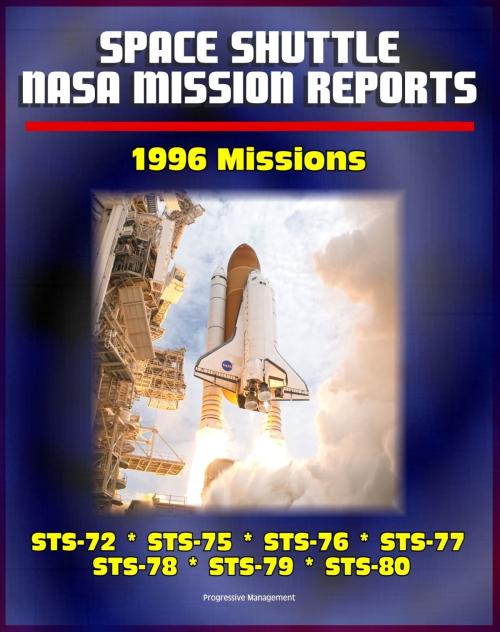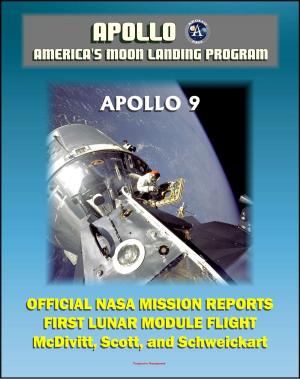Space Shuttle NASA Mission Reports: 1996 Missions, STS-72, STS-75, STS-76, STS-77, STS-78, STS-79, STS-80
Nonfiction, Science & Nature, Science, Physics, Astronomy, Other Sciences, History| Author: | Progressive Management | ISBN: | 9781465806932 |
| Publisher: | Progressive Management | Publication: | January 14, 2012 |
| Imprint: | Smashwords Edition | Language: | English |
| Author: | Progressive Management |
| ISBN: | 9781465806932 |
| Publisher: | Progressive Management |
| Publication: | January 14, 2012 |
| Imprint: | Smashwords Edition |
| Language: | English |
These official final program mission reports issued by the NASA Johnson Space Center cover missions in 1996: STS-72, STS-75, STS-76, STS-77, STS-78, STS-79, and STS-80. In these thorough reports, with information and specifics not available on NASA website mission descriptions, each orbiter system is reviewed in detail along with technical information on performance and anomalies.
STS-72: The primary objectives of this flight were to retrieve the Japanese Space Flyer Unit (SFU) and deploy and retrieve the Office of Aeronautics and Space Technology-Flyer (OAST-Flyer).
STS-75: The primary objectives of this flight were to perform the operations necessary to fulfill the requirements of the Tethered Satellite System-1 R (TSS-1R), and the United States Microgravity Payload-3 (USMP-3). The secondary objectives were to complete the operations of the Orbital Acceleration Research Experiment (OARE), and to meet the requirements of the Middeck Glovebox (MGBX) facility and the Commercial Protein Crystal Growth (CPCG) experiment.
STS-76: The primary objectives of this flight were to rendezvous and dock with the Mir Space Station and transfer one U. S. Astronaut to the Mir. A single Spacehab module carried science equipment and hardware, Risk Mitigation Experiments (RMEs), and Russian Logistics in support of the Phase 1 Program requirements. In addition, the European Space Agency (ESA) Biorack operations were performed.
STS-77: The primary objectives of this flight were to successfully perform the operations necessary to fulfill the requirements of Spacehab-4, the SPARTAN 207/lnflatable Antenna Experiment (IAE), and the Technology Experiments Advancing Missions in Space (TEAMS) payload.
STS-78: The primary objective of this flight was to successfully perform the planned operations of the Life and Microgravity Spacelab experiments. The secondary objectives of this flight were to complete the operations of the Orbital Acceleration Research Experiment (OARE), Biological Research in Canister Unit-Block II (BRIC), and the Shuttle Amateur Radio Experiment ll-Configuration C (SAREX-II).
STS-79: The primary objectives of this flight were to rendezvous and dock with the Mir Space Station and perform the exchange of a Mir Astronaut. A double Spacehab module carried science experiments and hardware, Risk Mitigation Experiments (RMEs) and Russian Logistics in support of the Phase 1 Program requirements.
STS-80: The primary objectives of this flight were to perform the operations necessary to fulfill the requirements of the Orbiting Retrievable Far and Extreme Ultraviolet Spectrometer-Shuttle Pallet Satellite (ORFEUS-SPAS) and Wake Shield Facility (WSF).
These official final program mission reports issued by the NASA Johnson Space Center cover missions in 1996: STS-72, STS-75, STS-76, STS-77, STS-78, STS-79, and STS-80. In these thorough reports, with information and specifics not available on NASA website mission descriptions, each orbiter system is reviewed in detail along with technical information on performance and anomalies.
STS-72: The primary objectives of this flight were to retrieve the Japanese Space Flyer Unit (SFU) and deploy and retrieve the Office of Aeronautics and Space Technology-Flyer (OAST-Flyer).
STS-75: The primary objectives of this flight were to perform the operations necessary to fulfill the requirements of the Tethered Satellite System-1 R (TSS-1R), and the United States Microgravity Payload-3 (USMP-3). The secondary objectives were to complete the operations of the Orbital Acceleration Research Experiment (OARE), and to meet the requirements of the Middeck Glovebox (MGBX) facility and the Commercial Protein Crystal Growth (CPCG) experiment.
STS-76: The primary objectives of this flight were to rendezvous and dock with the Mir Space Station and transfer one U. S. Astronaut to the Mir. A single Spacehab module carried science equipment and hardware, Risk Mitigation Experiments (RMEs), and Russian Logistics in support of the Phase 1 Program requirements. In addition, the European Space Agency (ESA) Biorack operations were performed.
STS-77: The primary objectives of this flight were to successfully perform the operations necessary to fulfill the requirements of Spacehab-4, the SPARTAN 207/lnflatable Antenna Experiment (IAE), and the Technology Experiments Advancing Missions in Space (TEAMS) payload.
STS-78: The primary objective of this flight was to successfully perform the planned operations of the Life and Microgravity Spacelab experiments. The secondary objectives of this flight were to complete the operations of the Orbital Acceleration Research Experiment (OARE), Biological Research in Canister Unit-Block II (BRIC), and the Shuttle Amateur Radio Experiment ll-Configuration C (SAREX-II).
STS-79: The primary objectives of this flight were to rendezvous and dock with the Mir Space Station and perform the exchange of a Mir Astronaut. A double Spacehab module carried science experiments and hardware, Risk Mitigation Experiments (RMEs) and Russian Logistics in support of the Phase 1 Program requirements.
STS-80: The primary objectives of this flight were to perform the operations necessary to fulfill the requirements of the Orbiting Retrievable Far and Extreme Ultraviolet Spectrometer-Shuttle Pallet Satellite (ORFEUS-SPAS) and Wake Shield Facility (WSF).















